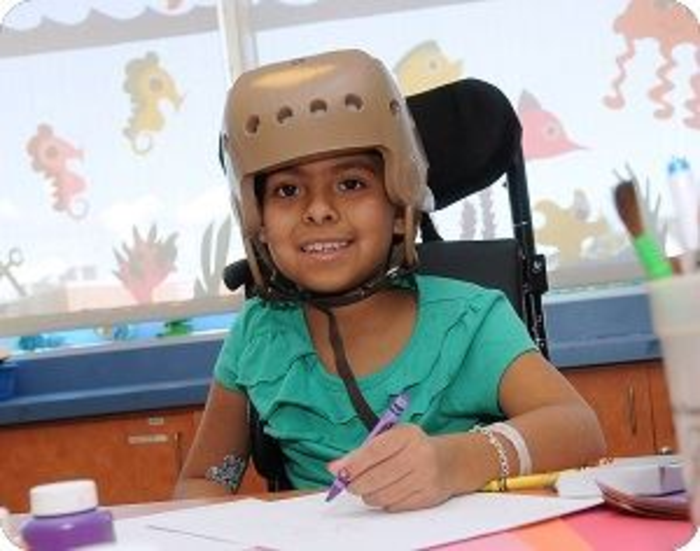East Hanover, NJ. April 29, 2022. A team of New Jersey researchers conducted a sleep study in inpatients in pediatric rehabilitation using an actigraph, a wrist-worn accelerometer that enables noninvasive continuous monitoring of sleep-wake cycles. This study is the first to use this rest-activity ratio as a measure of sleep-wake regulation in children with brain injury during inpatient rehabilitation. The team’s findings were reported in “Examining the use of a rest-activity ratio in a pediatric rehabilitation setting,” (DOI: 10.1016/j.apmr.2021.12.027), published online on January 31, 2022, by the Archives of Physical Medicine & Rehabilitation.

Credit: Children’s Specialized Hospital
East Hanover, NJ. April 29, 2022. A team of New Jersey researchers conducted a sleep study in inpatients in pediatric rehabilitation using an actigraph, a wrist-worn accelerometer that enables noninvasive continuous monitoring of sleep-wake cycles. This study is the first to use this rest-activity ratio as a measure of sleep-wake regulation in children with brain injury during inpatient rehabilitation. The team’s findings were reported in “Examining the use of a rest-activity ratio in a pediatric rehabilitation setting,” (DOI: 10.1016/j.apmr.2021.12.027), published online on January 31, 2022, by the Archives of Physical Medicine & Rehabilitation.
Authors are Anthony H. Lequerica, PhD, Jean Lengenfelder, PhD, and John DeLuca, PhD, from Kessler Foundation, Hannah Aura Shoval, MD, from Rutgers New Jersey Medical School, Krishan Yalamanchi, MD, and Claire Marchetta, MPH, from Children’s Specialized Hospital, and Jessica Ace, MD, from JFK-Johnson Rehabilitation Institute.
The sleep disruptions that occur during inpatient rehabilitation can adversely affect daytime alertness, interfering with the ability to participate in therapy and impeding cognitive and physical recovery after brain injury. Few studies have addressed this problem in pediatric rehabilitation. Establishing objective measures for sleep in this population is the first step toward improving sleep and maximizing rehabilitation outcomes.
The team tested children aged 8 to 17 years admitted for inpatient rehabilitation, comprising three groups: traumatic brain injury (n=14), nontraumatic brain injury (n=16), and controls (n=13). All participants wore the actigraph (Philips Actiwatch Spectrum Plus) for one week, yielding 5-day averages of rest-activity ratios. Functional status was measured by WeeFIM Cognitive and WeeFIM Motor scores.
“We found lower rest-activity ratios in both brain injury groups compared with the control group,” said lead author Dr. Lequerica, “suggesting poorer sleep-wake regulation in the children with brain injury. The children with lower rest-activity ratios tended to have lower WeeFim Cognitive scores on admission,” he added. “While further research is needed, actigraphy appears to be a promising noninvasive method for measuring rest-activity ratios in children with brain injury. Looking at how the rest-activity ratio changes over time may provide insight into their course of recovery.”
Funding source: Church & Dwight Employee Giving Fund (purchase of ActiWatches)
For information on pediatric rehabilitation research studies, contact: [email protected].
About Children’s Specialized Hospital
Children’s Specialized Hospital, an RWJBarnabas Health facility, is the nation’s leading provider of inpatient and outpatient care for children from birth to 21 years of age facing special health challenges–from chronic illnesses and complex physical disabilities like brain and spinal cord injuries, to a full scope of developmental, behavioral, and mental health concerns. At 15 different New Jersey locations, our pediatric specialists partner with families to make our many innovative therapies and medical treatments more personalized and effective so each child can reach their full potential.
About Kessler Foundation
Kessler Foundation, a major nonprofit organization in the field of disability, is a global leader in rehabilitation research that seeks to improve cognition, mobility, and long-term outcomes, including employment, for people with neurological disabilities caused by diseases and injuries of the brain and spinal cord. Kessler Foundation leads the nation in funding innovative programs that expand opportunities for employment for people with disabilities. For more information, visit KesslerFoundation.org.
Stay Connected with Kessler Foundation
Twitter | Facebook | YouTube | Instagram | iTunes & SoundCloud
Press contacts:
Deb Hauss, senior staff writer, 973.324.8372, [email protected]
Carolann Murphy, senior medical writer, [email protected]
Graphics:
A child in inpatient pediatric rehabilitation for brain injury.
Credit: Children’s Specialized Hospital, with permission.
Journal
Archives of Physical Medicine and Rehabilitation
DOI
10.1016/j.apmr.2021.12.027
Method of Research
Experimental study
Subject of Research
People
Article Title
Examining the use of a rest-activity ratio in a pediatric rehabilitation setting
COI Statement
none




